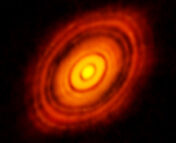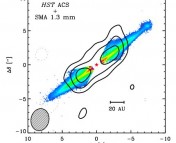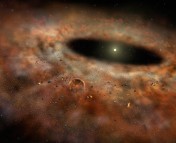Authors: Sasha Hinkley, Elisabeth C. Matthews, Charlène Lefevre, et al.
First Author’s Institution: Astrophysics Group, University of Exeter, Exeter, UK
Status: Published on ApJ [open access]

About the author: Maria Vincent is a second year graduate student at the Institute of Astronomy, University of Hawaiʻi at Mānoa. Currently, her work is centered on planet formation by observing circumstellar disks through direct imaging, as well as the instrumentation behind direct imaging processes using facilities on Maunakea.
What is a debris disk?
The story of planets and their host stars begins in a large cloud of gas and dust. As a young protostar condenses out of this cloud through gravitational collapse, additional material remains as a flattened gas-rich disk in order to conserve angular momentum. This is a protoplanetary disk. The dust in these disks eventually grow to larger and larger sizes, forming icy and rocky structures called planetesimals — which are the seeds of planets as we see them today. Over several millions of years, as dust in the disk gets used up, collisions between these planetesimals lead to accretion of material that eventually form planets and produce a second generation of dust. That is a debris disk. These dust-rich disks can persist for tens of millions of years. They are detected at infrared wavelengths through the scattering of starlight, and their thermal emission at radio wavelengths. They constitute a vital stage of planet formation, as they have embedded planets being born in a mess or planets at the prime of their youth going through a chaotic period in their lives. So, one can surmise that studying these structures is imperative, as they help us understand planet formation and how a planetary system like our Solar System came to be.
Finding and imaging a disk
In this paper, the authors discovered a debris disk around BD+45°598, a young K1-type star rich in lithium. The lithium content derived from its spectroscopy and its kinematics show it to be a part of the β Pictoris moving group — a group of stars including β Pictoris that are thought to have all formed out of the same cloud of gas and dust at the same time. The star is hence approximated to be about 23 million years old. Its spectral type and very young age makes it an interesting object to characterize and study the early evolution of a planetary system around a star like our Sun.
The disk itself was discovered from images obtained using high contrast imaging at the Keck Observatory taken at 2.2 microns, i.e. infrared light. High contrast imaging is used when you are looking for a faint source located close to a bright source, like a planet or a brown dwarf close to a bright star. On ground-based telescopes, this is achieved through a confluence of three techniques — adaptive optics, coronagraphy, and differential imaging. Adaptive optics is an optical technique that corrects for the distortion of the incoming light due to turbulence in the atmosphere. Coronagraphy involves using a ‘mask’ to block direct light from the host star to increase the visibility of the faint companion. And differential imaging is a mix of observing and image processing techniques to remove starlight from the signal corresponding to the companion, by subtracting a model built from stacked images of the target or of a similar star.
All of these methods together gave an image that showed an edge-on structure along the plane of the star, as shown in the left panel of Fig 1. To confirm that this indeed was a disk and not some artefact that appeared after extracting and processing the images, the same star was also observed using the SCUBA-2 instrument at the James Clerk Maxwell Telescope (JCMT), as well as the Submillimeter Array (SMA). While the JCMT data didn’t show a detection, the SMA observations showed some excess flux that coincides with the location of the disk seen in the images from Keck.

Measuring the disk properties
To better constrain the geometry of the disk, a cleaner, less-noisy model of the disk was generated based on the observations. The geometry tells us how the dust in the disk is scattered, which helps us draw constraints on where planets can form within this disk. The synthetic image of the disk is generated using software which approximates how light is scattered by the dust grains in the disk. The software computes the fluxes and images of the dust using some given parameters on the grain properties and distribution to arrive at the scattered light image. This model is then calibrated for the instrumental response by modifying it with the corresponding point spread function (a Gaussian) using a mathematical operation called convolution. From the best-fit model (shown in the middle panel of Fig 1), we learn that the disk has a radius of about 70 AU and is inclined at 87° (0° corresponds to the disk oriented face-on to an observer, and 90° means the disk is completely edge-on), with a position angle of 110° east of North. Since we mostly see just the edge of the disk, it is difficult to say how far from the host star the disk is actually present. And since the data doesn’t have a good enough resolution, they were not able to detect any structural features, like a gap, which is needed to know whether there is a planet in there or not.
Conclusions
It was concluded the disk around BD+45°598 is a dust-rich disk similar to AU Mic, the first debris disk to be discovered. There are differences between the two systems, like in the radius, which is larger in the case of BD+45°598. But the radius of this debris disk is not fully certain due to its orientation. It is also an example of a late-type member, or in other words, a star with surface temperature lower than our Sun, of a young moving group based on its age, spectral composition and its motion through our galaxy, which is comparable to the other stars in the β Pictoris moving group. Given its age of about 23 Myr its close distance of 70 parsecs, it is a potential target to look for larger-than-Jupiter companions closer to the host star. The limits of detection are shown in a contrast curve in Fig 2. Jupiter-sized planets tend to form closer in within the first few million years of the system. This can be done using smaller telescopes, like the 8 or 10 m telescopes on the ground, which can look at smaller fields closer to the star. Smaller companions are formed further away, and to observe these wider fields we need to use a larger telescope like JWST.

Astrobite edited by Ali Crisp
Featured image credit: European Southern Observatory




